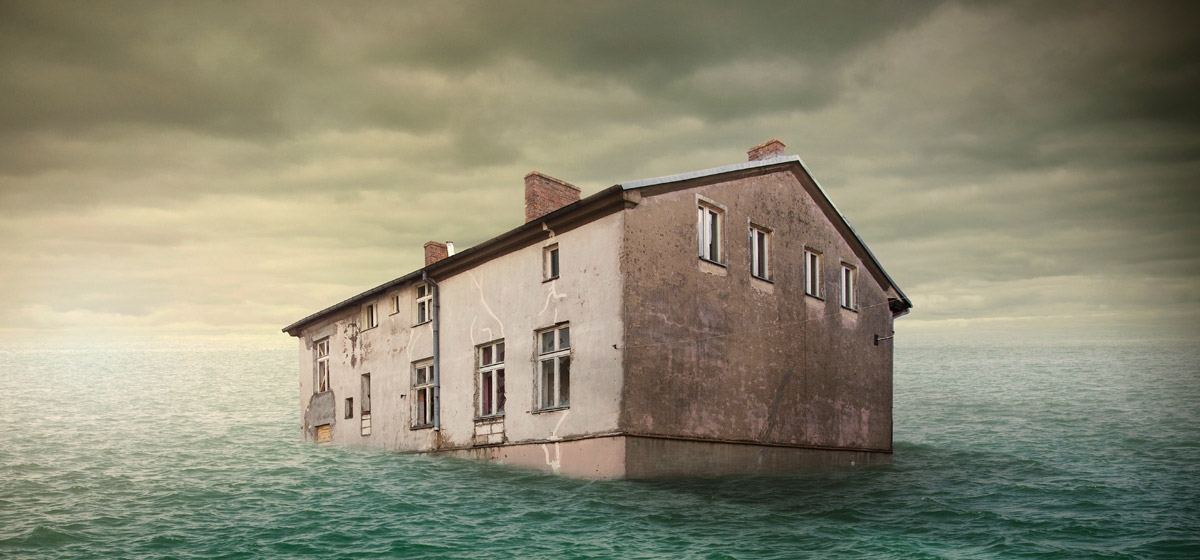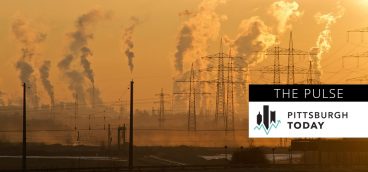
As his rowboat swept over Penn Avenue, Charles H. Allard looked for the bronze tablet on the Horne’s building. The object commemorated the high water mark of the Flood of 1907, previously the most severe flood to ravage Pittsburgh. Allard, reporting for the Pittsburgh Post-Gazette on March 18, 1936, couldn’t see it.
Allard and two photographers boarded the boat the day after flood waters surged 46 feet, drowning downtown. “The water was so high, our boat would have barely passed under the marquee at the Stanley Theater [now the Benedum],” he wrote.
Crowds, stranded at social events the previous night, stood on rooftops and balconies. One man pleaded with Allard to ferry food from the William Pitt Hotel to 50 trapped people. Another crowd clustered on the Smithfield Street Bridge, staring at the rushing, brown Monongahela below.
Fires broke out in Etna, roasting five stranded people alive. Thousands crowded the West End Bridge in McKees Rocks, watching in horror as one man drowned and another was swallowed by the river after an attempt to save him.
Post-Gazette reporter Charles F. Danver surveyed the damage from Liberty Avenue, where water was shallow enough to swish through. He described “a bedlam of auto horns, bells, sirens, and the vague apprehensive mumbling of a besieged metropolis. The cafes that have not yet closed are the gathering place of stunned and bewildered merchants who have seized a half hour or so to bolster their courage with a stiff drink or two. Worried and sad, they urge one another to have something; misery loves company. ‘I don’t know what to do. This never happened to me,’ they lament, shaking their heads.”
The ’36 flood submerged two-thirds of the downtown business district and killed 153 people. Shuttered mills put 60,000 steel workers out of work, and the overall damage estimate was $250 million—$4.3 billion in 2015 dollars.
Every decade or so, Pittsburgh gets clobbered by a flood that swallows up the Point (or comes close). According to National Oceanic and Atmospheric Administration records, floods of 30 feet or more rolled through Pittsburgh 11 times over the last century: in 2004, 1996, 1972, 1964, 1954, 1945, 1942, 1937 (twice), 1936 and 1924.
The Flood of 1936 was the most devastating. The disaster was caused by a few unseasonably warm days, quickly melting ice and snow into the rivers, followed by heavy rain. A combination with that severity is rare. The Pittsburgh Geological Society classified the ’36 event as a “500-year flood,” meaning there’s a 1-in-500 chance of such a catastrophe in any given year. But it could become more common.
The meteorological cocktail that wreaks havoc—increased precipitation, warmer springs, drastic and abrupt changes in seasons—is expected to be among the direct effects of climate change in Pennsylvania. A 2008 state-specific report from the Union of Concerned Scientists states that, “Over the last century, annual precipitation in the state has changed markedly, with increases of between 5 and 20 percent experienced in different regions.” The conclusion: “Should the state follow the regional trend, extreme rainfall events would be expected to produce more flash flooding, which threatens lives, property and water-supply infrastructure such as dams.”
“When you look at climate models… it’s getting wetter. When you look at the most severe rainfall events, you will see them getting more severe and happening more often.”
— Jordan R. Fischbach, co-director,
Rand Corporation’s Water and Climate Resilience Center
While the validity and causes of climate change is still debated within U.S. politics, the world scientific consensus is steadfast: It is happening and human activity, mostly the burning of fossil fuels, is the cause. The most recent assessment by the United Nations Intergovernmental Panel on Climate Change—produced by thousands of contributors and citing more than 6,000 peer-reviewed studies—states: “Human influence on the climate system is clear,” and “Warming of the climate system is unequivocal, and since the 1950s, many of the observed changes are unprecedented over decades to millennia. The atmosphere and ocean have warmed, the amounts of snow and ice have diminished, and the sea level has risen.” NASA and the U.S. Environmental Protection Agency also have emphasized climate change as a major, measurable concern.
The impact will be severe to coastal cities, where the EPA predicts “shoreline erosion, coastal flooding and water pollution.” The Union of Concerned Scientists forecasts a tripling in tidal floods in most areas stretching from the East Coast to the Gulf of Mexico. But inland cities are not off the hook.
“When you look at climate models and turn them inland, it’s getting wetter,” says Jordan R. Fischbach, co-director of the Rand Corporation’s Water and Climate Resilience Center. “When you look at the most severe rainfall events, you will see them getting more severe and happening more often.”
If people were to cease burning fuels tomorrow, global temperatures would rise only a single degree, says Kelly Klima, a research scientist at Carnegie Mellon University’s Department of Engineering and Public Policy. But the effect is expected to be enough to jolt all weather patterns. As Klima says, “It accelerates the entire system.”
In hurricane-prone areas, storm systems will become more frequent and severe. Places impacted by drought will be drier longer. And where there has always been flooding, the water will rush more frequently with greater crests.
Pennsylvania can expect more dangerously hot days and a change in agriculture, and Pennsylvanians also will be affected by shocks to the global economy, as the costs of mitigating climate change and natural disasters increase.
Despite Pittsburgh’s safety from rising sea levels, climate change will likely impact every aspect of local life over the next century, experts say. Most pressing, researchers and policy experts have begun to ask: What happens when the kind of flooding that once happened every decade happens every three or four years? Will the control systems put into place since 1936 hold back another worst-case scenario?
The aging Atlas: Restraining flood waters
When the Lewis and Clark expedition passed through Pittsburgh in August 1803, members rowed past the Point in an Ohio River just inches deep. Meriwether Lewis noted that they had “to get out all hands and lift the boat over about thirty yards.”
The deeper Ohio of today is the product of the water control system built in the aftermath of the flood of 1936. Its dual purposes are flood control and maintaining depth for barge traffic.
Civic groups had pleaded with the federal government for a flood control system during the first third of the 20th century. Pittsburgh was subjected to six horrifying 30-foot flood crests from 1900 until 1925. But it took the desolation of ’36 (a result of a weather pattern that caused flooding through the Northeast) to push the idea through Congress.
Today, the U.S. Army Corps of Engineers administers 23 dams and 15 reservoirs in its Pittsburgh District, but the actual control system affecting the three rivers extends all the way to New York State. The system holds back floodwaters and allows the corps to strategically empty reservoirs during the spring thaw/rain season. The corps estimates that the system has prevented about $10 billion in damage in its nearly eight decades of service.
And there is serious concern that it is rotting away.
“The problem is most of these systems are much older than what we recommend,” says Gregory Scott, a senior project manager at the engineering firm of Buchart Horn and member of the American Society of Civil Engineers. Pittsburgh saw a swell of water system construction after Congress passed the Flood Control Act of 1938, and that continued through the post-war economic boom. Little replacement and renovation has been done since.
Scott chairs the committee that put together a “report card” for Pennsylvania’s infrastructure. (The ASCE issues one for each state every four years.) The grade for Pennsylvania’s dams? C-. For its levees? Also C-. For the storm water systems that will dispose of the increased rainfall predicted under climate change? D+.
“Concrete doesn’t last forever,” says Werner Loehlein, chief of the Pittsburgh District Army Corps water management section since 1974. “The greatest enemy to engineers is erosion. As time goes on, things fall apart, if you don’t have money to maintain and repair them—even more so in Pittsburgh, where we had some of the first federally funded navigational projects. We have the oldest infrastructure.”
Since 1956, federal infrastructure spending has remained at about 2.5 percent of gross domestic product, according to a 2015 Congressional Budget Office report. However, increasing construction material costs mean that spending since 2003 has effectively decreased by 9 percent.
“With climate change, we know the intensity of the storms will increase,” Scott says. “We should be beefing up the system. Instead, we are begging to maintain what we have. That’s what’s disconcerting to me. We’re not having talks about mitigating this.”
What would the collapse of this system in a severe flood look like?
“It wouldn’t be a wall of water pushing through the city,” Scott says. “It wouldn’t be Johnstown,” referring to the catastrophic 1889 dam failure that washed away the town. But each dam break along the line would knock off another few feet of protection. Currently, flood control systems withhold 12 to 14 feet of water from the Point.
Loehlein says it will be impossible to predict which dam(s) would break in a 1936-like catastrophe until it happens.
Scott is more concerned about the region’s storm water system, administered by the Allegheny County Sanitary Authority. It’s an aging cobbled-together infrastructure, much of it even older than the dam system. The system handles both storm water and household discharges, a kind of dual usage rarely implemented in newer cities. Regular rain overwhelms it and sends raw sewage into the three rivers. The EPA has threatened Alcosan with fines over its continual dumping into the rivers, forcing the agency to plan a whole new system that will cost between $2 billion and $4 billion. That plan is underway. However, Scott predicts the current system will be overwhelmed by the increased rainfall of climate change. This, of course, means more nastiness in the rivers, but also a nagging threat to nearby infrastructure. “When [water] lines break,” he says, “it damages high-speed fiber [internet] cables, infrastructure and causes sink holes.”
Waterproof city planning and higher insurance
In 1998, the city finalized plans for PNC Park, knowing that, just two years prior, the new home of the Pirates was a periodic swamp. The flood of 1996 crested at 36 feet, submerging that slice of the North Side. The city was putting a $228 million asset in a flood plain, so PNC Park was constructed with some special features, including a 1,100-foot-long bulkhead wall buried between the park and the Allegheny River, essentially raising the riverbank four feet. (Fans walk on top of it when they cross either of the two walkways stretching from the Roberto Clemente Bridge to the statue of Mister Rogers.) A wall, 750 feet long and 14 feet high, was installed along the outfield to keep out floodwater.
“When economics don’t warrant a structural solution, you have to use a floodplain management program to just manage the areas at the greatest risk of flooding,” Loehlein says.
That’s what Pittsburgh is doing at the behest of the Federal Emergency Management Agency. In 2014, FEMA redrew maps identifying flood plains for several counties, including Allegheny, for the Federal Flood Insurance Program. Under the program, property owners in flood plains can buy insurance not usually offered by private insurers from the government, provided their city or town has adopted certain rules to minimize damage.
The new maps increased Pittsburgh’s flood-plain area slightly, adding Washington Boulevard, Banksville Road and a swath of the Strip District. New buildings in the flood plains must be built with the lowest floor 18 inches above the marker for a 100-year-flood. Old buildings have to be brought up to that standard if the owner invests 50 percent or more of the property’s market value in a renovation. (Some historic homes and storage facilities are exempt.)
The flood insurance program overhaul also saw a 25 percent premium increase for most policies, plus new surcharges—due to FEMA’s debt from disasters like hurricanes Katrina and Sandy.
Pittsburgh homeowners can bemoan paying the cost of relief to seaside cities, but they should expect more of that, says Matthew Kahn, a public policy professor at UCLA who researches the relationship between economics and climate change.
“You have the federal government subsidizing the risk of people choosing to live in at-risk areas,” Kahn says. This prevents the U.S. from naturally rearranging its population centers in response to climate change, and it also penalizes people living in comparatively safer cities. “The federal government feels obligated to create the illusion of safety, and all of us pay for that, not the people who chose to live and build there.”
After Sandy, New York State began lobbying the feds for money for a seawall to protect New York City, Kahn says, “even though New York is a very wealthy city. And given New York’s clout, I think it will work.”
“Those cities that can deliver safety from climate change will have an extra competitiveness. I think Pittsburgh might do well.”
— Matthew Kahn, climate/economy researcher and public policy professor, UCLA
Grapes, not coal: a different Pennsylvania
In September 2014, researchers at the University of Cambridge calculated that the cost of climate change to the global economy would reach $43 trillion by 2200. No researcher has pinpointed the cost to western Pennsylvania, but several have educated guesses.
“Pennsylvania might have an environment a lot like Alabama,” says Klima, the CMU climate researcher. “Corn doesn’t grow in Alabama. There may have to be a shift of where we grow certain crops. We’ve heard that Pennsylvania might become a wine area, if grapes can grow.”
Once climate change has a palpable effect on everyday life, one industry crucial to Appalachia might be phased out. “Looking years in the future, I’d be surprised if anyone says, ‘Who cares about climate change? Let’s burn coal!’ ” says Dr. Keith Crane, director of the Rand Corporation’s Environment, Energy, and Economic Development Program. Natural gas is cheaper, and coal plants are being retired every year. Coal industry employment has declined considerably in places like Pennsylvania and West Virginia. If people are feeling the effects of climate change day to day, how will the coal industry justify its existence?
As for hydraulic fracturing, Crane says drillers shouldn’t worry yet. “There is some debate as to whether or not natural gas is a transition fuel.” That could keep it politically safe as Americans become even more climate-conscious.
Certain simple costs of doing business of any kind might go up. “Businesses will need more air conditioning, so that increases electric costs,” says Dr. Matthias Ruth, a professor of both public policy and civil engineering at Northeastern University. “With the flooding of roads, transportation will cost more. Of course, all this means insurance will be more expensive.”
Climate change, however, might have a silver lining for Pittsburgh. It could attract companies fleeing the coasts. Yes, Pennsylvania may suffer increases in flooding and other problems, but those might seem minor compared with sea level rises and increased hurricane damage predicted for Miami and New York.
UCLA’s Kahn notes that half of the U.S. population lives on a coast and more than half of its capital is there. Corporations naturally will want to move their assets to safer places, and Kahn foresees a time when Wall Street’s trading floor moves to northern Connecticut to avoid flooding.
“Those cities that can deliver safety from climate change will have an extra competitiveness,” he says. “I think Pittsburgh might do well.”
Shaping the future
How else will climate change impact Pittsburgh? Climate researchers have some educated guesses, but they don’t know when and how average Pittsburghers will feel the impact, only that they will.
This is one reason the issue is being taken up by the newest facet of municipal government—bolstering the city’s adaptability to a wide range of threats.
Last December, the Rockefeller Foundation added Pittsburgh to its list of 100 Resilient Cities. The $100 million program gives money to cities around the globe to hire a “chief resilience officer” to help the municipality “adapt to the shocks and stresses of our world and transform them into opportunities for growth.” Each city employs a policy wonk to study common issues that confront city residents, and will continue to in the future, and the city doesn’t have to find the cost in its coffers.
In Pittsburgh, that wonk is Grant Ervin, a 37-year-old with a master’s in international affairs, who was previously the city’s sustainability manager. The Peduto administration added to the $300,000 from the Rockefeller Foundation and also hired Rebecca Kiernan as senior resilience coordinator, and Ari Lattanzi, a former AmeriCorps fellow working for the city, as resilience analyst.
For Ervin, the city’s chief resilience officer, “the definition [of resilience] has to require an expansion of the ability of the system to adapt and strengthen in advance of a crisis.” Specifically, he is looking at the local impacts of three broad, crisis-causing issues: urbanization, globalization and climate change.
The city has a multistage plan that begins with a “preliminary resilience assessment,” a report pulled together with input from civic groups and citizens.
The future they envision isn’t pleasant, particularly regarding climate change. “The way we’ve been thinking, there will be acute shocks to our poor and vulnerable populations in the forms of heat waves and river flooding,” Lattanzi says. “We’re thinking of a five-degree heat increase by mid-century, with more heat morbidity of the very young and very old, more rainfall, more sewer overflow. Winter storms will provide more snow, with colder temperatures. People on the edge of poverty will get pushed into poverty by energy costs and economic shocks.”
Flash floods, like the one that suddenly swallowed Washington Boulevard in August 2011 killing four people, will be more common, Ervin predicts. “We need to think of what we can put upstream to contain that.”
The resilience group’s hyper-local focus has allowed them to contemplate not just major disasters, but small calamities that could result from more water in the ecological system. Ervin foresees an increase in sink holes, particularly in the Hill District, and rockslides down Mount Washington.
“The purpose of this strategy is to be prepared up front, be able to operate efficiently in an emergency and position the city to come out in a better place,” Ervin says.
The goal is to prevent a situation like the ’36 flood, where frightened residents knocked back whiskey and held back tears, aghast at a hell-scape that was predictable. Considering the inevitability of climate change, that might be the best outcome any regional government can offer.
“This is a major challenge for the city, just like building an infrastructure after 1936 and providing for the army during World War II,” Ervin says. “And it is up to us to rise to the occasion. We need to figure out how to use education and civic engagement as a way to shape the future.”




